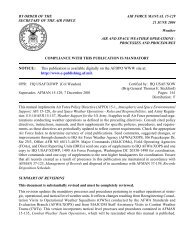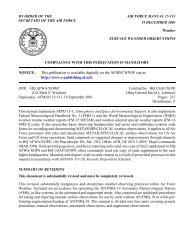Joint Metoc Handboo - IHMC Ontology and Policy Management
Joint Metoc Handboo - IHMC Ontology and Policy Management
Joint Metoc Handboo - IHMC Ontology and Policy Management
You also want an ePaper? Increase the reach of your titles
YUMPU automatically turns print PDFs into web optimized ePapers that Google loves.
9-US Army<br />
allowing use of the TROJAN SPIRIT communications path on a non-interference<br />
basis. IMETS Block I system upgrade will also add TCP/IP capability.<br />
• GCCS-A (Army Global Comm<strong>and</strong> <strong>and</strong> Control System). Army component of GCCS.<br />
Army’s tactical link into the SIPRNET.<br />
9.4 Army METOC Data<br />
9.4.1 Army METOC Data Sources.<br />
The US Air Force provides the bulk of weather support required by the Army. This<br />
includes direct support to Army garrisons provided by USAF Operational Weather<br />
Squadrons (OWSs) in accordance with AFI 15-126, Aerospace Weather Operations. Air<br />
Force Army weather support CWTs provide operational weather support to assigned Army<br />
customers during exercises, training, contingencies, <strong>and</strong> war. In addition to the forecasting<br />
<strong>and</strong> observing support provided by Air Force combat weather teams (CWT), the Army has<br />
organic resources which provide supplemental reports of METOC conditions. The<br />
following represents the most significant sources of weather data within the Army tactical<br />
structure: ARTYMET sections, Air Traffic Service (ATS) units, engineer units (FALOP),<br />
ground reconnaissance <strong>and</strong> surveillance elements (FALOP), imagery interpretation<br />
elements, brigade <strong>and</strong> battalion intelligence personnel (FALOP), <strong>and</strong> aviation<br />
squadrons/brigades.<br />
Each Army element possesses a limited measuring capability designed to meet its own<br />
immediate needs. Consequently, their weather observing capabilities are supplemental to<br />
their primary mission. They should not be viewed as a replacement or substitute for USAF<br />
CWT support. USAF weather observation responsibility ends at the division Comm<strong>and</strong><br />
Post (CP).<br />
• Artillery Meteorological Sections. ARTYMET sections provide meteorological data<br />
for artillery firing units. They also provide upper-air observations <strong>and</strong> artillery limited<br />
surface observations (ALSOs) to Air Force CWT.<br />
- ARTYMET sections are organized to support the ballistic meteorological<br />
requirements of artillery units. Each division artillery (DIVARTY) meteorological<br />
section <strong>and</strong> separate brigade meteorological section accompanies its own artillery.<br />
Each field artillery brigade has a meteorological team assigned <strong>and</strong> deployed where<br />
it can best support overall meteorological requirements. Other meteorological<br />
sections are deployed where they can best acquire the data needed. For instance,<br />
the need for fallout meteorological messages requires that one meteorological<br />
section be usually designated to produce fallout data.<br />
- Meteorological sections are located where they can best sound the atmosphere<br />
through which weapon trajectories will pass. The section should be well forward<br />
<strong>and</strong> within the general proximity of a compatible communications facility.<br />
Considerations in selecting the position for a meteorological section are:<br />
9-5




